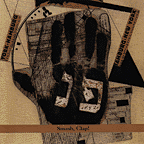Naftule's Dream / Smash, Clap!

Naftule's Dream
Smash, Clap!
tzadik, 1998 TZ 7125
Starting off with an urgent air raid warning, clearing the air, this album tumbles into a joyous energy and urgency that surpass even the wonderful "In search of the golden dreydl." Opening with a reprise of "Black Wedding", an instrumental that closed their first Shirim album, "of angels and horseraddish".
Indeed, even as I want to say that this album moves far beyond klezmer into exploring new music--not particularly Jewish music, rather, new music as is played by a tight, brass-blessed ensemble who have played much klezmer together, who have also listened to a lot of edge music of all stripes. Thus, the "Yid in Seattle", despite the fact that it more features Dave Harris' trombone over Glenn Dickson's clarinet, still has a krechts and even a sense of "kvetch" that inform a freer, more relaxed jazz/prog rock improvisational innard. There is a part of me that finds myself harking back to the approach of, say, Weather Report, at times, and then finding myself going, "oh, don't be silly! this is klezmer!".
Here's the irony. Even though this album feels freer of the "klezmer" label that still haunted the first Naftule's Dream album, there is more here that is definably, obviously klezmer. The more the band has integrated the various tunes and sounds in its collective head, the more things have become distinct parts of something that feels much more organically whole. Thus, "Friend of Kafka," feels like an altered doina that drops periodically into sort of free jazz-ish modes where the sounds, say, trombone and clarinet, bounce off each other, eschewing formal melody. And then, the melody is back, a machine-driven, Chaplin-in-Modern-Times lament against gears and constantly recurring riffs played at incredibly complex, changing and foot-confusing tempos. Oops. That part pulls in everything from cartoon movie music to jazz, and it's something that sounds great on the ears (assuming that exploratory drive sounds good to you), despite not actually being klez. Then, we have the healing, oriental (in the older sense, referring to Jewish and Eastern European sounds) wanderings of "Something is there," a doina, after all, despite the occasional heavy guitar riff, the the more complexly rhythmic post-doina ensemble explorations, or the very klezmer musings of the gentle "Yash the Chimney Sweep."
Here's another irony. Where many of the musicians recording for John Zorn's "Radical Jewish Culture" label are using the recordings as a place to explore what "Jewish" means, or might mean for them, looking inward. This does not appear to be Naftule's Dream's dream. Rather, having explored Yiddish culture and klezmer, they are looking out to see where it leads them.
In this sense, the music is far more connected to the specific worlds of experimental music than many of the label's other recordings, and especially true to the sense of creating new music grounded in "Jewish" (whatever that means). Of course, if we follow that thought, we find ourselves right back at the "Haskalah," the age of Jewish enlightenment and the furor of experimentation created by Jewish creativity breaking beyond the pale. It's a fascinating turn of thought, and the sort of fascinating turn of thought that one feels whilst engrossed in music as involving and exciting as "Free Klez", or the urgency of "Speed Klez." (I might add that the David Harris piece, "Speed Klez," is a delightful exploration of music which bears no resemblance to the speed-guitar-styled genre, "speed klez," perfected--if that's the term we want--by some alleged klezmer/rock fusion bands.)
Thoughts of the Haskalah and Jewish history in the last two centuries are heightened by the use of an El Lissitsky painting on the CD cover. Lissitsky was part of the intense thriving of Yiddish culture in the former Soviet Union that followed the revolution. That particular flowering was destroyed, not by the Nazis, but by Stalin (with Lissitsy being the rare person who managed to die of mere disease in 1941, possibly having finally come to regret some of his work as a propagandist for Stalin; hopefully, not questioning at all the legacy of art and architecture and typography he left behind). But here's the thing about this particular dialogue and outpouring of passion and creative exploration of the avant garde. It's back, and one listen to "Smash, Clap!" will make it clear why it couldn't be suppressed.
Oh, the music. This is music that defines the edges, and will define the edges ten years from now. To have an ensemble of so many amazing musicians, pulling together and integrating so much of the world around them, is actually not so rare. To have it sound so good, that's special. Smash! Clap! Clap! Clap!
Reviewed by Ari Davidow, 7/23/00
Personnel this recording:
Glenn Dickson: B-flat and C clarinets
David Harris: trombone
Michael McLaughlin: piano
Pete Fitzpatrick: electric guitar
John Manning: tuba
Eric Rosenthal: drums
Songs
- Black Wedding (Glenn Dickson) 6:45
- Yid in Seattle (Michael McLaughlin) 4:21
- Friend of Kafka (Glenn Dickson) 5:32
- The Aimless Path (David Harris) 3:37
- Free Klez 1 & 2 (Michael McLaughlin) 3:24
- Free Klez 3 & 4 (Michael McLaughlin) 7:25
- Speed Klez (David Harris) 3:06
- Something is there (Glenn Dickson) 6:09
- The Wanderer (David Harris) 9:34
- Emperor Red (Michael McLaughlin) 2:12
- Yash the Chimney Sweep (Glenn Dickson) 4:27
- Afterwards (Michael McLaughlin) 5:16

